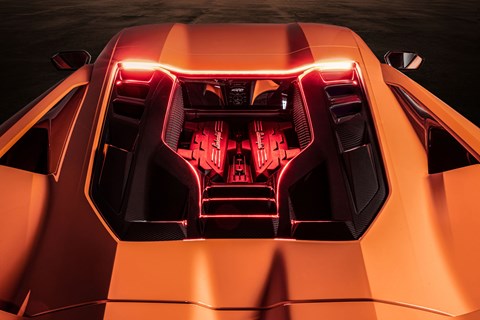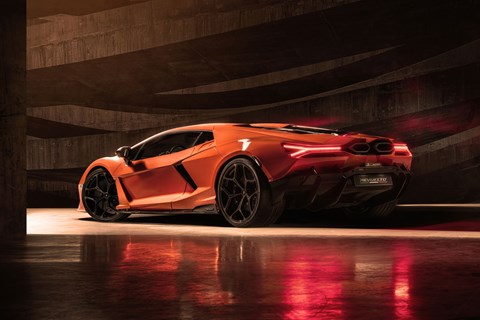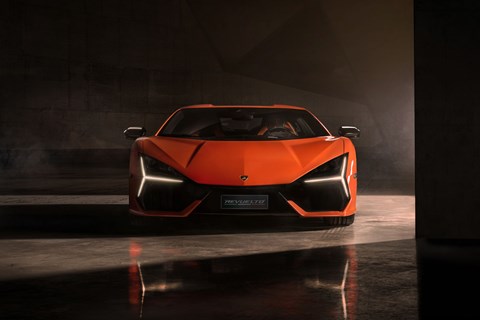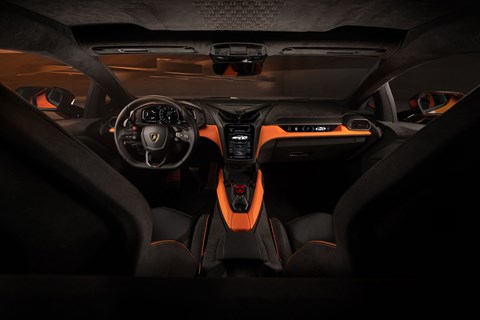► Circa 1000bhp V12 hybrid powertrain
► Four-wheel drive, new cabin, 13 drive modes
► Priced at around £450k
Say hello to Lamborghini’s latest flagship hypercar. Named the Revuelto, it’s the long-awaited replacement for the bombastic Aventador and – hold the front page – it’s a hybrid. Naturally, there’s still room for a 6.5-litre V12, while major updates to the chassis, cabin and design add up to create the most advanced Lamborghini production car ever. However, we’ve heard on the grapevine that prices are likely to start from around £450k so the question is, will it be worth it?
6.5-litre V12 engine + hybrid assistance
Let’s talk about the big V12 first. It’s based on the same unit that was used in the Aventador, yet there’s been a few changes to extract more punch. For example, Lamborghini’s redesigned the air intake ducts to the cylinders, improved the compression ratio and tweaked the fluid dynamics of the exhaust to reduce counter pressure at high revs. And, while it might not create any extra power, 17kg has been shaved off the total weight of the engine so it comes in at just 218kg.

The result of all of the above is some predictably outrageous figures. Total power from the engine is rated at 813bhp peaking at 9,250rpm (the red line is at 9,500rpm), while 535lb ft maximum torque arrives at 6,750rpm. However, that’s only part of the story, as for the first time ever in a production series Lamborghini, there’s a hybrid element to supplement the bombastic engine.
No doubt the idea of teaming a 6.5-litre V12 with a 3.8kWh lithium battery won’t be lost on people, but if you ask the question of whether the huge engine could even exist without the tiny electric element, then the answer is almost certainly no. Sant’Agata has dabbled in this sort of thing before with the special edition Sian and its supercapacitor-enabled hybrid element, but this is the finished product and one that will help halve average CO2 for Lamborghini models by 2025.
Said system also allows the Revuelto to deliver all-electric all-wheel drive. Each front wheel gets its own oil-cooled axial flux electric motor delivering 110kW of power (and allowing electronic torque vectoring), while a third motor sits atop of the eight-speed double clutch gearbox and can provide drive to the rear wheels.

In order to make all of this fit, the Revuelto gets a heavily revised layout to the Aventador. The battery pack (around 1.5m long and 0.3m high) sits inbetween the driver and passenger seats where the transmission would usually be, this instead shifted behind the V12.
To join everything up, the engine (spun through 180 degrees) is positioned longitudinally while the gearbox sits in a transverse arrangement – the result being its centre of gravity is as close to the middle of the car as possible. All in, the Revuelto makes 1000bhp and while there’s no word yet on kerb weight, 0-62mph is confirmed at 2.5 seconds with top speed in excess of 217mph.
What’s the electric range like?
Before we get into this, Lamborghini is at pains to point out that the electric element isn’t specifically designed to allow for all electric running – its primary job is to complement the performance and efficiency of the V12. Or, in other words, it’s there to make the V12 socially acceptable.
As such, EV range (while unconfirmed) will likely be as little as 6 miles – and probably less if conditions are anything but perfect. The battery can be charged using a regular domestic supply or via a 7kW charger (the latter taking around 30 mins from empty). However for those in a hurry the Recharge powertrain mode can juice the battery in just six minutes.
How many drive modes are there?
13 to be precise, all selectable by two toggles on the steering wheel. One taking care of powertrain mode (either Recharge, Hybrid or Performance) and the other mimicking more traditional drive modes (City, Road, Sport, Track and Track ESC OFF). Sounds complicated, but McLaren has made a similar system work with its hybrid models and it’s certainly no more intricate than the interface on modern Ferraris.

What about the chassis?
The whole car is designed around what Lamborghini calls its monofuselage. Brand new for the Revuelto, it’s made of carbon fibre and as such is 10% lighter than the Aventador chassis with torsional rigidity also up by 25%.
Integral to this structure is the monolithic rocker ring. Formed out of carbon fibre reinforced plastic, it forms the supporting structure of the car and encloses and connects the forged composite elements such as the tub, front firewall and A-pillar. Benefits of using forged composites include greater efficiency and sustainability, thanks to reduced energy demands of cooling equipment and less waste material.

Carbon fibre also extends to the entire front structure and allows a 20% reduction in weight versus the aluminium equivalent on the Aventador and a doubling of energy absorption. It’s not all carbon, though, with the rear chassis being formed from high-strength alluminium alloys. Within this structure are two hollow castings in the rear dome area that integrate the rear suspension’s shock towers and powertrain suspension into a single component with a closed inertia profile – thus reducing the weight and amount of welding lines, while upping rigidity.
Lamborghini claims an optimum weight distribution of 44 at the front and 56 at the rear for the Revuelto, plus stiffened anti-roll bars (up 11% front, 50% rear compared with the Aventador) will add further agility. Specially developed Bridgestone Potenza tires provide the grip, while huge 10-pot brakes on the front axle take care of stopping power. A new central brain for the car, named Dinamica Veicolo 2.0, promises to bring the myriad powertrain and chassis elements together.
What’s the cabin like?
There’s no denying the the Aventador’s cabin was the full supercar experience – and not in a good way. The Revuelto makes efforts to fix this and early impressions are positive. There’s more headroom and space in general (the driver’s seat is 3mm lower than the Aventador) while cupholders and a place to put your phone are small details that are hugely welcome.

A trio of screens have also been introduced – a digital dash for the driver, central infotainment monitor and a passenger information display (just like the ones seen in Ferraris). Users can ‘swipe’ items between the screens, an example being a pre-programmed sat-nav display being pushed from the central screen to the digital dash.
When can I buy one?
Despite the humongous price tag, the Revuelto’s order books are filling up fast. Production is slated to start in Q2 of 2023, while first deliveries will begin in Europe at some point in Q4. For those wanting to get their hands on a Lamborghini V12, this will almost certainly be the last opportunity.
Lamborghini’s CEO Stephan Winkelmann explained that the Revuelto’s lifespan is likely to be similar to the Aventador’s, a timeframe that goes beyond the 2030 UK cut off for sales of ICE vehicles. Beyond this, the future for Lamborghini looks all-electric, with Winkelmann suggesting that – as it stands – there will not be ICE versions of the brand’s cars for markets that may still allow combustion engines. Indeed, by 2024 Lamborghini is set to include some electric element in its entire product range, while 2028 should see the introduction of its first ever EV.
